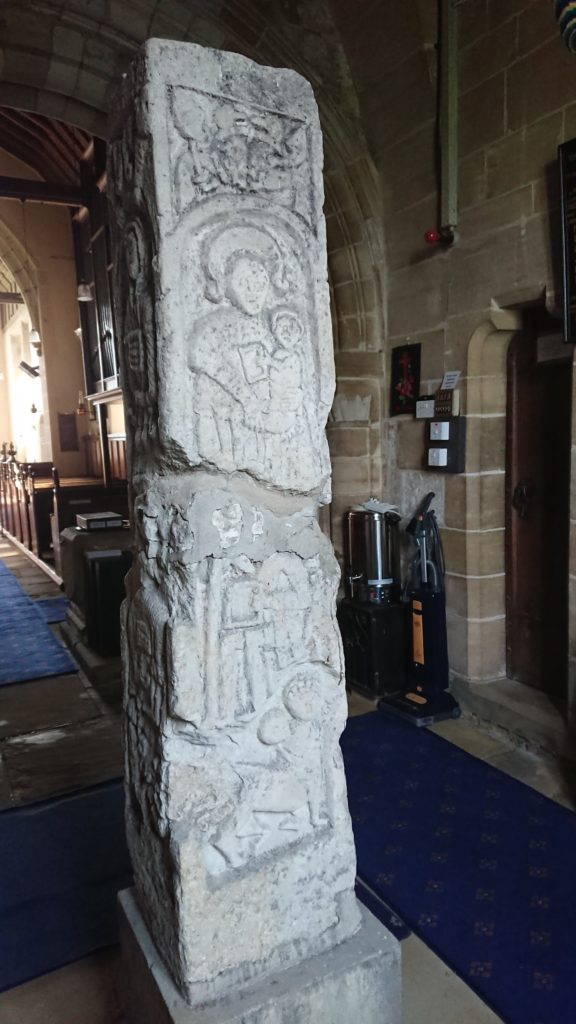The Nunburnholme Cross is a piece of carved, broken and mended Saxon stone housed in the Parish church of Nunburnhome near Pocklington in East Yorkshire. It’s unremarkable except for being there.
It’s not as well carved as the Ruthwell Cross, but it has a similar message. That message is in several layers. First the stone: the oldest part. Then the carvings: the age old story of the Gospel of Jesus Christ. Then the destruction: torn down, buried and forgotten. Then the resurrection….

This cross belongs to no one, just as the cross story cannot be claimed to belong to any one sect or group. I don’t know then it was damaged but I do know that Nunburnholme was damaged, by the decree of a deranged king, Henry VIII. In 1539 the monasteries were suppressed and least amongst these was a very small, some say the smallest, group of Benedictine Sisters living under the Rule of St Benedict in Nunburnholme.

I am linked to them. I am a Lay Benedictine and this blog is about living the Rule of St Benedict in the 21st century. Not that I’m very good at it. I’m like the damaged cross, rough and still here. I’m like the suppressed sisters: surplus to requirements.
1539 was a time of high culture wars when the establishment decided that ordinary people would toe the line and give up the rules and rituals they had tried to live by. Much of the country side was trampled as walls were knocked down, treasures were stolen and Religious paid off. So is that English enough for the new Culture Secretary, I wonder. It seems to me the current culture wars are, of course, very selective.
There are bits we like. Let’s keep those. There are bits we don’t like. Let’s hide, forget or destroy those. Only it doesn’t work like that. The bits you want rid of always come back and bite you on the bum. The Ruthwell Cross and the Nunburnholme Cross are witnesses to that.
There is a story, that goes back 2 thousand years in these islands, which has been interpreted in stone and on paper and in lives throughout that time. The basic story is still there, in the landscape, as people have tried to make sense of it and live it all of that time. It has welcomed and embraced people from countless different cultures from across the globe and is the better for it. There are still bits that are rough and rankle, at least with me. A recent post I read on Twitter lamented the lack of female deacons in the Catholic Church. Read on dear reader…
In the One Holy Catholic and Apostolic Church there are and always have been female deacons. It’s just some branches of that One Holy Catholic and Apostolic Church don’t recognise them. Just like the story of the small group of Benedictine sisters at Nunburnholme has been forgotten, so have they. Just as too many good servants have been made surplus to requirements, so have they.
But just like those bits of unremarkable stone, they still exist and are still exercising their ministries in the One Holy Catholic and Apostolic Church. During the first lockdown in 2021 I read a book about female ministers of European origin finding new holy places on routes across North America in the 19th century. Surplus to requirements in one place they found space in another.
I am still finding a space, for holy service and holy communion. I have found the Lay Community of St Benedict is a good space in which to explore that. In my Bambi, the Mobile Chapel of St Scholastica, I celebrate, the forgotten sisters of Nunburnholme and I sing a song of high revolt to the interpretations that exclude and damage and destroy those who would follow the Gospel of Jesus Christ.

So do we need a Rule for that? Maybe. I’m still working on that, as this blog will no doubt demonstrate.
Janet Lees, a friend of St Scholastica and a Member of the Lay Community of St Benedict, after wandering through East Yorkshire. 19.09.2021.
Note: ‘One Holy Catholic and Apostolic Church’ are words used in the service of ordination in the United Reformed Church.

This is a piece which has made me think a lot Janet.
Firstly about the maybe thousands of women who have created spaces with crosses, alters, or other special items or signifiers. Your travelling Bambi is so apt for post covid and post institutional Christendom.
Secondly I am not so easily one who searches out history as the stories of ancient women and connects them to now. I am so glad you have this skill of doing that and communicating their abs our stories with seeming ease.
Lastly I have been reading Terry Tempest Williams’ book this week named When Women Were Birds. It’s reflections on voice. It made me think of you, of so many women who do speak and are not silenced and will resist being surplus to requirements. If God invented people, somehow, then it’s quite bonkers to have the notion that anyone in all creation could ever be surplus to requirements isn’t it!
Thank you Kate, you are very kind and supportive. Voice is so very important to me. I will look for that book.